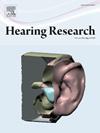NF2-related schwannomatosis: A view from within the inner ear
IF 2.5
2区 医学
Q1 AUDIOLOGY & SPEECH-LANGUAGE PATHOLOGY
引用次数: 0
Abstract
NF2-related schwannomatosis (NF2-SWN, formerly known as neurofibromatosis type 2) is an autosomal dominant disorder associated with the growth of bilateral schwannomas on the cochleo-vestibular nerves and meningiomas. NF2-SWN is caused by pathogenic variations in the NF2, moesin-ezrin-radixin-like (MERLIN) tumour suppressor gene. The mostly benign tumours can cause progressive sensorineural hearing loss, tinnitus and balance dysfunction. Outside the inner ear, tumours grow on other intra-cranial nerves, leading to further neurological issues and shortened life-expectancy. Here we re-evaluate some historic cases from our human temporal bone collection, and we review similar instances from the literature to highlight the structural and functional effects of such tumours on the cochlea and vestibular organs. Tumour growth is associated with the remodelling of sensory and ion-transporting epithelia, the loss of afferent neurons and hair cells, and signs of fluid dysregulation. These cases demonstrate the aggressive nature of this disease and the difficulties of surgically excising the bilateral tumours. They also emphasise the need for novel therapies that can slow or prevent tumour growth to preserve sensory function in people living with NF2-SWN.
nf2相关的神经鞘瘤病:内耳观察
nf2相关神经鞘瘤病(NF2-SWN,以前称为2型神经纤维瘤病)是一种常染色体显性遗传病,与耳蜗前庭神经和脑膜瘤的双侧神经鞘瘤生长有关。NF2- swn是由NF2, moesin-ezrin-radixin样(MERLIN)肿瘤抑制基因的致病性变异引起的。大多数良性肿瘤可引起进行性感音神经性听力丧失、耳鸣和平衡功能障碍。在内耳外,肿瘤在其他颅内神经上生长,导致进一步的神经问题,缩短预期寿命。在这里,我们重新评估一些历史病例从我们的人类颞骨收集,我们回顾类似的情况下,从文献中强调这类肿瘤对耳蜗和前庭器官的结构和功能的影响。肿瘤生长与感觉上皮和离子转运上皮的重塑、传入神经元和毛细胞的丧失以及体液失调的迹象有关。这些病例表明这种疾病的侵袭性和手术切除双侧肿瘤的困难。他们还强调需要能够减缓或阻止肿瘤生长的新疗法,以保持NF2-SWN患者的感觉功能。
本文章由计算机程序翻译,如有差异,请以英文原文为准。
求助全文
约1分钟内获得全文
求助全文
来源期刊

Hearing Research
医学-耳鼻喉科学
CiteScore
5.30
自引率
14.30%
发文量
163
审稿时长
75 days
期刊介绍:
The aim of the journal is to provide a forum for papers concerned with basic peripheral and central auditory mechanisms. Emphasis is on experimental and clinical studies, but theoretical and methodological papers will also be considered. The journal publishes original research papers, review and mini- review articles, rapid communications, method/protocol and perspective articles.
Papers submitted should deal with auditory anatomy, physiology, psychophysics, imaging, modeling and behavioural studies in animals and humans, as well as hearing aids and cochlear implants. Papers dealing with the vestibular system are also considered for publication. Papers on comparative aspects of hearing and on effects of drugs and environmental contaminants on hearing function will also be considered. Clinical papers will be accepted when they contribute to the understanding of normal and pathological hearing functions.
 求助内容:
求助内容: 应助结果提醒方式:
应助结果提醒方式:


